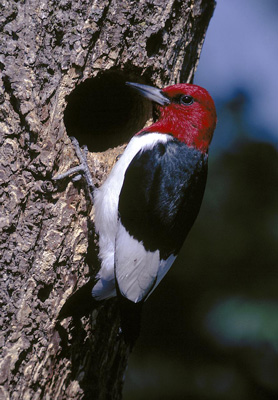
When our independent statewide Iowa Audubon organization was started, the board of directors decided that a characteristic native bird should be selected for the group's emblem. After several species were discussed, the Red-headed Woodpecker became an obvious choice. Perhaps no other species so represents Iowa's colorful bird life, habitat concerns, and Iowa's determined conservationists as does this familiar creature.
Red-headed Woodpeckers are common summer (and sometimes winter, depending on food availability) residents of Iowa's savannas, overgrown pastures, woodland edges and farm groves. Where trees are sparse, as in much of western and north central Iowa, the bird may substitute utility poles for their preferred tree trunks. Melanerpes erythrocephalus is defined by its Latin species name, which translates as red (erythro) head (cephalus). It is closely related to America's western acorn woodpeckers, and Lewis' Woodpecker is the western counterpart of our Red-headed, having the same general food and habitat preferences.
Less common today than in former times, Red-headed Woodpeckers are declining throughout their range, of which Iowa occupies an important portion. Both the national Partners in Flight and Iowa's State Wildlife Action Plan have recognized it as a species of conservation concern. At least two human-related threats appear to be part of the problem. Loss of their favored savanna woodlands to clearing for agriculture or neglected overgrowth has resulted in reduced suitable habitat. Add competition for nest cavities by European Starlings (an introduced species) and the adverse affects upon Red-headed Woodpeckers are multiplied.
Red-headed Woodpeckers are quite omnivorous, feeding on things such as grubs, ants, wasps, June beetles, crickets, millipedes, spiders, corn, dogwood berries, strawberries, grapes, acorns, sap (from 'wells' drilled by sapsuckers), suet, sunflower seeds, raisins, breadcrumbs, small songbird eggs and even mice. They also catch insects on the wing, darting from perches in a very flycatcher-like manner. If you put grape jelly out to attract Baltimore Orioles, RHWs may chase them away and claim the jelly for their own favored treat.
Adult males and females appear similar, while immatures have a brown head and neck. Both parents incubate nests of 3-10 (usually 4-5) eggs for a period of about 13 days until hatching. Nesting generally occurs from May into July, with 2 broods raised in some parts of their range. Red-headed Woodpeckers sometimes are known by colorful local names, including flag bird, half-a-shirt, and jelly coat.
Look for this very familiar species to grace Iowa Audubon's letterhead, newsletter masthead, organizational signs, T-shirts and other items produced for our group.
The Red-headed Woodpecker is also on National Audubon's Watchlist of birds of special concern.